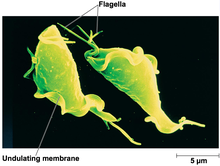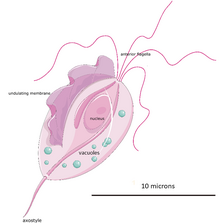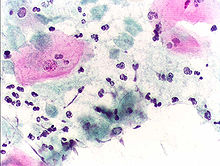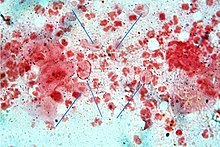Trichomonas vaginalis
| Trichomonas vaginalis | |
|---|---|

| |
| Trichomonas vaginalisobserved by scanning electron microscopy showing the axostyle (ax), the anterior flagella (af) and the undulating membrane (rf).[1] | |
| Scientific classification | |
| Domain: | Eukaryota |
| Phylum: | Metamonada |
| Order: | Trichomonadida |
| Family: | Trichomonadidae |
| Genus: | Trichomonas |
| Species: | T. vaginalis
|
| Binomial name | |
| Trichomonas vaginalis (Donné1836)
| |
Trichomonas vaginalisis ananaerobic,flagellatedprotozoanparasite and the causative agent of asexually transmitted diseasecalledtrichomoniasis.It is the most commonpathogenicprotozoan that infects humans in industrialized countries.[2]Infection rates in men and women are similar but women are usually symptomatic, while infections in men are usually asymptomatic. Transmission usually occurs via direct, skin-to-skin contact with an infected individual, most often through vaginal intercourse. TheWHOhas estimated that 160 million cases of infection are acquired annually worldwide.[3]The estimates forNorth Americaalone are between 5 and 8 million new infections each year, with an estimated rate ofasymptomaticcases as high as 50%.[4]Usually treatment consists ofmetronidazoleandtinidazole.[5]
Clinical
[edit]


History
[edit]Alfred Francois Donné(1801–1878) was the first to describe a procedure to diagnose trichomoniasis through "the microscopic observation of motile protozoa in vaginal or cervical secretions" in 1836. He published this in the article entitled, "Animalcules observés dans les matières purulentes et le produit des sécrétions des organes génitaux de l'homme et de la femme" in the journal,Comptes rendus de l'Académie des sciences.[6]With it, he created the binomial name of the parasite asTrichomonas vaginalis.[7]
Symptoms
[edit]
Infection withTrichomonas vaginalis,calledtrichomoniasis,is a sexually transmitted infection of theurogenital tractand a common cause ofvaginitisin women, while men with this infection can display symptoms ofurethritisas well as symptoms of prostate infection.[8]'Frothy', greenish vaginal discharge with a 'musty' malodorous smell is characteristic.[9]Someone that is infected with Trichomoniasis may or may not display symptoms associated with an infection. Common symptoms for both males and females include burning, itching, and discomfort when urinating or engaging in sexual intercourse. When symptoms of a trichomoniasis infection are present it is recommended to receive immediate treatment to avoid the infection lasting for an extended period within the host body.[10]
Signs
[edit]For those infected withTrichomonas vaginalis,many people are asymptomatic. The signs can be difficult to ascribe to trichomoniasis as they are common signs that can be associated with many other sexually transmitted infections. Around 70% of those infected do not present any signs, but when they are exhibited, men and women do differ. Once infection ensues, signs could take 5 to 28 days to present themselves.[11]
Men with this infection can experience itching and discomfort inside the penis, unusual discharge, and burning after ejaculation. Women similarly experience itching, burning, soreness, and discoloration of the vulva and vagina.[12]Additionally, women can experience discolored discharge with a fish-like odor and discomfort while peeing. In severe cases, about 40% of women can also develop a cervical disorder known as a "strawberry cervix" (copitis macularis) in which the cervix appears to have small red dots covering the surface, which is indicative of blood vessel hemorrhaging.[13][14]
Complications
[edit]Some of the complications ofTrichomonas vaginalisin women include:preterm delivery,low birth weight, and increased mortality as well as predisposing toHIVinfection,AIDS,andcervical cancer.[15]Trichomonas vaginalishas also been reported in theurinary tract,fallopian tubes,and pelvis and can causepneumonia,bronchitis,and oral lesions.Condomsare effective at reducing, but not wholly preventing, transmission.[16]
Trichomonas vaginalisinfection in males has been found to cause asymptomaticurethritisandprostatitis.[17]It has been proposed that it may increase the risk of prostate cancer; however, evidence is insufficient to support this association as of 2014.[17]
Diagnosis
[edit]
Classically, with acervical smear,infected women may have a transparent "halo" around their superficial cell nucleus but more typically the organism itself is seen with a slight cyanophilic tinge, faint eccentric nuclei, and fine acidophilic granules.[18]It is unreliably detected by studying a genital discharge or with a cervical smear because of their lowsensitivity.Trichomonas vaginalisis also routinely diagnosed via a wet mount, in which "corkscrew" motility is observed. Currently, the most common method of diagnosis is via overnight culture,[19][20]with a sensitivity range of 75–95%.[21]Newer methods, such asrapid antigen testingandtranscription-mediated amplification,have even greater sensitivity, but are not in widespread use.[21]The presence ofTrichomonas vaginaliscan also be diagnosed byPCR,using primers specific for GE NBA NK/L23861.[22]
Treatment
[edit]Infection is treated and cured withmetronidazole[23]ortinidazole.The CDC recommends a one time dose of 2 grams of either metronidazole or tinidazole as the first-line treatment; the alternative treatment recommended is 500 milligrams of metronidazole, twice daily, for seven days if there is failure of the single-dose regimen.[24]Medication should be prescribed to anysexual partner(s) as well because they may beasymptomatic carriers.[9][25]
Morphology
[edit]
Trichomonas vaginalisexists in only one morphological stage, atrophozoite,and cannot encyst (or form cysts.) This protozoan does not typically adhere to one shape, as in different conditions, the parasite has the ability to change. When in culture separate from the host, it usually displays a more "pear" or oval shaped morphology, but when present in a living host, specifically on the epithelial cells of the vaginal wall, the shape is more "amoeboid".[26]It is slightly larger than a white blood cell, measuring 9 × 7μm.In both forms,Trichomonas vaginalishas five flagella – four protruding from the front or anterior of the parasite and the fifth on the back or posterior end.[27][8]The functionality of the fifth flagellum is not known. In addition, a barb-likeaxostyleprojects opposite the four-flagella bundle. All of these flagella are connected to an "undulating" membrane.[28]The axostyle may be used for attachment to surfaces and may also cause the tissue damage seen in trichomoniasis.[29]The nucleus is usually elongated, and is located near the anterior end of the protozoan within the cytoplasm which contains manyhydrogenosomes(closed-membrane organelle with the ability to produce both ATP and hydrogen while in anaerobic conditions.)[8]
WhileTrichomonas vaginalisdoes not have acystform, organisms can survive for up to 24 hours in urine, semen, or even water samples. A nonmotile, round, pseudocystic form with internalized flagella has been observed under unfavorable conditions.[30]This form is generally regarded as a degenerate stage as opposed to a resistant form,[30]although viability of pseudocystic cells has been occasionally reported.[31]The ability to revert to trophozoite form, to reproduce and sustain infection has been described,[32]along with a microscopic cellstainingtechnique to visually discern this elusive form.[33]
Protein function
[edit]Trichomonas vaginalislacksmitochondriaand therefore necessaryenzymesandcytochromesto conductoxidative phosphorylation.It obtains nutrients by transport through thecell membraneand byphagocytosis.The organism is able to maintain energy requirements by the use of a small amount of enzymes to provide energy viaglycolysisofglucosetoglycerolandsuccinatein thecytoplasm,followed by further conversion ofpyruvateandmalateto hydrogen andacetatein anorganellecalled thehydrogenosome.[34]
Virulence factors
[edit]One of the hallmark features ofTrichomonas vaginalisis the adherence factors that allowcervicovaginal epitheliumcolonization in women. The adherence that this organism illustrates is specific to vaginalepithelial cells(VECs) beingpH,time and temperature dependent. A variety ofvirulence factorsmediate this process some of which are the microtubules, microfilaments,bacterial adhesins(4), andcysteineproteinases.The adhesins are four trichomonad enzymes called AP65, AP51, AP33, and AP23 that mediate the interaction of the parasite to the receptor molecules on VECs.[35]Cysteine proteinases may be another virulence factor because not only do these 30 kDa proteins bind to host cell surfaces but also may degradeextracellular matrixproteinslikehemoglobin,fibronectinorcollagen IV.[36]
Genome sequencing and statistics
[edit]TheTrichomonas vaginalisgenome is approximately 160megabasesin size[37]– ten times larger than predicted from earlier gel-based chromosome sizing.[38](The human genome is ~3.5gigabasesby comparison.[39]) As much as two-thirds of theTrichomonas vaginalissequence consists of repetitive andtransposable elements,reflecting a massive, evolutionarily recent expansion of the genome. The total number of predicted protein-coding genes is ~98,000, which includes ~38,000 'repeat' genes (virus-like, transposon-like,retrotransposon-like, and unclassified repeats, all with high copy number and lowpolymorphism). Approximately 26,000 of the protein-coding genes have been classed as 'evidence-supported' (similar either to known proteins, or toESTs), while the remainder have no known function. These extraordinary genome statistics are likely to change downward as the genome sequence, currently very fragmented due to the difficulty of ordering repetitive DNA, is assembled into chromosomes, and as more transcription data (ESTs,microarrays) accumulate. But it appears that the gene number of the single-celled parasiteTrichomonas vaginalisis, at minimum, on par with that of its hostH. sapiens.[citation needed]
In late 2007TrichDB.orgwas launched as a free, public genomic data repository and retrieval service devoted to genome-scale trichomonad data. The site currently contains all of theTrichomonas vaginalissequence project data, several EST libraries, and tools for data mining and display. TrichDB is part of the NIH/NIAID-fundedEupathDBfunctional genomics database project.[40]
Genetic diversity
[edit]Recent studies into the genetic diversity ofTrichomonas vaginalishas shown that there are two distinct lineages of the parasite found worldwide; both lineages are represented evenly in field isolates. The two lineages differ in whether or notTrichomonas vaginalisvirus (TVV) infection is present. TVV infection inTrichomonas vaginalisis clinically relevant in that, when present, TVV has an effect on parasite resistance to metronidazole, a first line drug treatment for human trichomoniasis.[41]
Increased susceptibility to HIV
[edit]The damage caused byTrichomonas vaginalisto the vaginal epithelium increases a woman's susceptibility to an HIV infection. In addition to inflammation, the parasite also causes lysis of epithelial cells and RBCs in the area leading to more inflammation and disruption of the protective barrier usually provided by the epithelium. HavingTrichomonas vaginalisalso may increase the chances of the infected woman transmitting HIV to her sexual partner(s).[42][43]
Evolution
[edit]The biology ofTrichomonas vaginalishas implications for understanding the origin of sexual reproduction in eukaryotes.Trichomonas vaginalisis not known to undergomeiosis,a key stage of the eukaryotic sexual cycle. However, when Maliket al.[44]examinedTrichomonas vaginalisfor the presence of 29 genes known to function in meiosis, they found 27 such genes, including eight of nine genes that are specific to meiosis inmodel organisms.These findings suggest that the capability for meiosis, and hence sexual reproduction, was present in recent ancestors ofTrichomonas vaginalis.21 of the 27 meiosis genes were also found in another parasiteGiardia lamblia(also calledGiardia intestinalis), indicating that these meiotic genes were present in a common ancestor ofTrichomonas vaginalisandG. intestinalis.Since these two species are descendants of lineages that are highly divergent amongeukaryotes,and the meiotic genes were likely present in a common ancestor of all eukaryotes.[44]
See also
[edit]References
[edit]- ^Dias-Lopes G, Saboia-Vahia L, Margotti ET, Fernandes NS, Castro CL, Oliveira FO, Peixoto JF, Britto C, Silva FC, Cuervo P, Jesus JB (October 2017)."Morphologic study of the effect of iron on pseudocyst formation in Trichomonas vaginalis and its interaction with human epithelial cells".Memórias do Instituto Oswaldo Cruz.112(10): 664–673.doi:10.1590/0074-02760170032.PMC5607515.PMID28953994.
- ^Soper, D (2004). "Trichomoniasis: under control or undercontrolled?".American Journal of Obstetrics and Gynecology.190(1): 281–90.doi:10.1016/j.ajog.2003.08.023.PMID14749674.
- ^Harp, Djana F.; Chowdhury, Indrajit (2011)."Trichomoniasis: Evaluation to execution".European Journal of Obstetrics & Gynecology and Reproductive Biology.157(1): 3–9.doi:10.1016/j.ejogrb.2011.02.024.PMC4888369.PMID21440359.
- ^Hook, Edward W. (1999)."Trichomonas vaginalis—No Longer a Minor STD ".Sexually Transmitted Diseases.26(7): 388–9.doi:10.1097/00007435-199908000-00004.PMID10458631.
- ^W Evan Secor."Trichomonas Vaginalis".MedScape.
- ^Donné, A. (19 September 1836)."Animalcules observés dans les matières purulentes et le produit des sécrétions des organes génitaux de l'homme et de la femme".Comptes Rendus Hebdomadaires des Séances de l'Académie des Sciences(in French).3:385–386.
- ^Diamantis, Aristidis; Magiorkinis, Emmanouil; Androutsos, George (2009)."Alfred Francois Donné (1801-78): a pioneer of microscopy, microbiology and haematology".Journal of Medical Biography.17(2): 81–87.doi:10.1258/jmb.2008.008040.ISSN0967-7720.PMID19401511.S2CID9287263.
- ^abcAsh, Lawrence; Orihel, Thomas (2007).Ash & Orihel's Atlas of Human Parasitology(5th ed.). American Society for Clinical Pathology Press.ISBN9780891891673.
- ^abNanda, N; Michel, RG; Kurdgelashvili, G; Wendel, KA (2006). "Trichomoniasis and its treatment".Expert Review of Anti-infective Therapy.4(1): 125–35.doi:10.1586/14787210.4.1.125.PMID16441214.S2CID43515177.
- ^CDC (2024-08-15)."About Trichomoniasis".Trichomoniasis.Retrieved2024-09-12.
- ^CDC (2024-09-12)."About Trichomoniasis".Trichomoniasis.Retrieved2024-09-19.
- ^CDC (2024-09-12)."About Trichomoniasis".Trichomoniasis.Retrieved2024-09-19.
- ^Schumann, Jessica A.; Plasner, Scott (2024),"Trichomoniasis",StatPearls,Treasure Island (FL): StatPearls Publishing,PMID30521247,retrieved2024-09-19
- ^Krieger, John N.; Wolner-Hanssen, Pâl; Stevens, Claire; Holmes, King K. (1990)."Characteristics of Trichomonas vaginalis Isolates from Women with and without Colpitis Macularis".The Journal of Infectious Diseases.161(2): 307–311.ISSN0022-1899.
- ^Schwebke, J. R.; Burgess, D. (2004)."Trichomoniasis".Clinical Microbiology Reviews.17(4): 794–803, table of contents.doi:10.1128/CMR.17.4.794-803.2004.PMC523559.PMID15489349.
- ^"Trichomoniasis".CDC Fact Sheet.Centers for Disease Control and Prevention. 2007-12-17.Retrieved2010-06-11.
- ^abCaini, Saverio; Gandini, Sara; Dudas, Maria; Bremer, Viviane; Severi, Ettore; Gherasim, Alin (2014). "Sexually transmitted infections and prostate cancer risk: A systematic review and meta-analysis".Cancer Epidemiology.38(4): 329–338.doi:10.1016/j.canep.2014.06.002.ISSN1877-7821.PMID24986642.
- ^Powers, Celeste N. (1998)."Diagnosis of Infectious Diseases: a Cytopathologist's Perspective".Clinical Microbiology Reviews.11(2): 341–65.doi:10.1128/CMR.11.2.341.PMC106836.PMID9564567.
- ^Ohlemeyer, C; Hornberger, L; Lynch, D; Swierkosz, E (March 1998). "Diagnosis ofTrichomonas vaginalisin adolescent females: InPouch TV culture versus wet-mount microscopy ".Journal of Adolescent Health.22(3): 205–8.doi:10.1016/S1054-139X(97)00214-0.PMID9502007.
- ^Sood, Seema; Mohanty, Srujana; Kapil, Arti; Tolosa, Jorge; Mittal, Suneeta (2007)."InPouch TV culture for detection ofTrichomonas vaginalis"(PDF).The Indian Journal of Medical Research.125(4): 567–71.PMID17598943.
- ^abHuppert, Jill S.; Mortensen, Joel E.; Reed, Jennifer L.; Kahn, Jessica A.; Rich, Kimberly D.; Miller, William C.; Hobbs, Marcia M. (2007)."Rapid Antigen Testing Compares Favorably with Transcription-Mediated Amplification Assay for the Detection ofTrichomonas vaginalisin Young Women ".Clinical Infectious Diseases.45(2): 194–8.doi:10.1086/518851.PMID17578778.
- ^Schirm, Jurjen; Bos, Petra A.J.; Roozeboom-Roelfsema, Irene K.; Luijt, Dirk S.; Möller, Lieke V. (2007). "Trichomonas vaginalisdetection using real-time TaqMan PCR ".Journal of Microbiological Methods.68(2): 243–7.doi:10.1016/j.mimet.2006.08.002.PMID17005275.
"Trichomonas vaginalisrepeated DNA target for PCR identification ".GenBank Nucleotide Database.2002-04-16. L23861.1.
Kengne P, Veas F, Vidal N, Rey JL, Cuny G (September 1994). "Trichomonas vaginalis:repeated DNA target for highly sensitive and specific polymerase chain reaction diagnosis ".Cell. Mol. Biol. (Noisy-le-grand).40(6): 819–31.PMID7812190. - ^"Metronidazole".Drugs.Retrieved23 February2018.
- ^Workowski, K.A.; Berman, S.; Centers for Disease Control and Prevention (CDC) (17 December 2010)."Sexually transmitted diseases treatment guidelines, 2010"(PDF).MMWR Recomm Rep.59(RR-12): 1–110.PMID21160459.Erratum in: MMWR Recomm Rep. 2011 Jan 14;60(1):18.
- ^Cudmore, S. L.; Delgaty, K. L.; Hayward-Mcclelland, S. F.; Petrin, D. P.; Garber, G. E. (2004)."Treatment of Infections Caused by Metronidazole-ResistantTrichomonas vaginalis".Clinical Microbiology Reviews.17(4): 783–93, table of contents.doi:10.1128/CMR.17.4.783-793.2004.PMC523556.PMID15489348.
- ^Petrin, Dino; Delgaty, Kiera; Bhatt, Renuka; Garber, Gary (April 1998)."Clinical and Microbiological Aspects of Trichomonas vaginalis".Clinical Microbiology Reviews.11(2): 300–317.ISSN0893-8512.PMID9564565.
- ^"CDC - DPDx - Trichomoniasis".cdc.gov.2024-06-07.Retrieved2024-10-03.
- ^"CDC - DPDx - Trichomoniasis".cdc.gov.2024-06-07.Retrieved2024-10-03.
- ^Ryan, Kenneth James; Ray, C. George; Sherris, John C., eds. (2004).Sherris Medical Microbiology(4th ed.). McGraw Hill.ISBN978-0-8385-8529-0.[page needed]
- ^abPetrin D, Delgaty K, Bhatt R, Garber G (April 1998)."Clinical and microbiological aspects ofTrichomonas vaginalis".Clin. Microbiol. Rev.11(2): 300–17.doi:10.1128/CMR.11.2.300.PMC106834.PMID9564565.
- ^Mielczarek E, Blaszkowska J (November 2015). "Trichomonas vaginalis:pathogenicity and potential role in human reproductive failure ".Infection.44(4): 447–458.doi:10.1007/s15010-015-0860-0.PMID26546373.S2CID33823038.
- ^Hussein EM, Atwa MM (December 2008). "Infectivity ofTrichomonas vaginalispseudocysts inoculated intra-vaginally in mice ".Journal of the Egyptian Society of Parasitology.38(3): 749–762.PMID19209760.
- ^Verges J (June 1979). "Les prostatites à trichomonas formes rondes (T.F.R.)" [Prostatitis due to the circular form of trichomonas].Journal d'Urologie et de Nephrologie(in French).85(6): 357–361.ISSN0021-8200.PMID490766.
- ^Upcroft, P.; Upcroft, J. A. (2001)."Drug Targets and Mechanisms of Resistance in the Anaerobic Protozoa".Clinical Microbiology Reviews.14(1): 150–64.doi:10.1128/CMR.14.1.150-164.2001.PMC88967.PMID11148007.
- ^Arroyo, R.; Engbring, J.; Alderete, J. F. (1992). "Molecular basis of host epithelial cell recognition byTrichomonas vaginalis".Molecular Microbiology.6(7): 853–862.doi:10.1111/j.1365-2958.1992.tb01536.x.PMID1602965.S2CID44364966.
- ^Mendoza-Lopez, M. R.; Becerril-Garcia, C.; Fattel-Facenda, L. V.; Avila-Gonzalez, L.; Ruiz-Tachiquin, M. E.; Ortega-Lopez, J.; Arroyo, R. (2000)."CP30, a Cysteine Proteinase Involved inTrichomonas vaginalisCytoadherence ".Infection and Immunity.68(9): 4907–12.doi:10.1128/IAI.68.9.4907-4912.2000.PMC101697.PMID10948104.
- ^Carlton, J. M.; Hirt, R. P.; Silva, J. C.; Delcher, A. L.; Schatz, M.; Zhao, Q.; Wortman, J. R.; Bidwell, S. L.; et al. (2007)."Draft Genome Sequence of the Sexually Transmitted PathogenTrichomonas vaginalis".Science.315(5809): 207–12.Bibcode:2007Sci...315..207C.doi:10.1126/science.1132894.PMC2080659.PMID17218520.
- ^Lehker, M. W.; Alderete, J. F. (1999). "Resolution of Six Chromosomes ofTrichomonas vaginalisand Conservation of Size and Number among Isolates ".The Journal of Parasitology.85(5): 976–9.doi:10.2307/3285842.JSTOR3285842.PMID10577741.
- ^Zimmer, C. (2007). "EVOLUTION: Jurassic Genome".Science.315(5817): 1358–9.doi:10.1126/science.315.5817.1358.PMID17347424.S2CID34154189.
- ^Aurrecoechea, Cristina; Brestelli, John; Brunk, Brian P.; Carlton, Jane M.; Dommer, Jennifer; Fischer, Steve; Gajria, Bindu; Gao, Xin; et al. (2009)."GiardiaDB and TrichDB: integrated genomic resources for the eukaryotic protist pathogensGiardia lambliaandTrichomonas vaginalis".Nucleic Acids Research.37(Database issue): D526–30.doi:10.1093/nar/gkn631.PMC2686445.PMID18824479.
- ^Conrad, Melissa D.; Gorman, Andrew W.; Schillinger, Julia A.; Fiori, Pier Luigi; Arroyo, Rossana; Malla, Nancy; Dubey, Mohan Lal; Gonzalez, Jorge; Blank, Susan (2012)."Extensive Genetic Diversity, Unique Population Structure and Evidence of Genetic Exchange in the Sexually Transmitted Parasite Trichomonas vaginalis".PLOS Neglected Tropical Diseases.6(3): e1573.doi:10.1371/journal.pntd.0001573.PMC3313929.PMID22479659.
- ^Mulla, Summaiyaa; Kosambiya, JK; Desai, Vikask; Shethwala, Nimishad (2009)."Sexually transmitted infections and reproductive tract infections in female sex workers".Indian Journal of Pathology and Microbiology.52(2): 198–9.doi:10.4103/0377-4929.48916.PMID19332911.
- ^Mavedzenge, Sue Napierala; Van der Pol, Barbara; Cheng, Helen; Montgomery, Elizabeth T.; Blanchard, Kelly; de Bruyn, Guy; Ramjee, Gita; Van der Straten, Ariane (2010)."Epidemiological Synergy ofTrichomonas vaginalisand HIV in Zimbabwean and South African Women ".Sexually Transmitted Diseases.37(7): 460–6.doi:10.1097/OLQ.0b013e3181cfcc4b.PMID20562586.S2CID19708165.
- ^abMalik SB, Pightling AW, Stefaniak LM, Schurko AM, Logsdon JM (2008)."An expanded inventory of conserved meiotic genes provides evidence for sex inTrichomonas vaginalis".PLOS ONE.3(8): e2879.Bibcode:2008PLoSO...3.2879M.doi:10.1371/journal.pone.0002879.PMC2488364.PMID18663385.
Further reading
[edit]- Hernández, Hilda M.; Marcet, Ricardo; Sarracent, Jorge (28 October 2014)."Biological roles of cysteine proteinases in the pathogenesis ofTrichomonas vaginalis".Parasite.21(54): 54.doi:10.1051/parasite/2014054.PMC4209856.PMID25348828.
External links
[edit]- TIGR'sTrichomonas vaginalisgenome sequencingproject.
- TrichDB: theTrichomonas vaginalisgenome resource
- NIH site ontrichomoniasis.
- Taxonomy
- eMedicine article ontrichomoniasis.
- Patient UK
